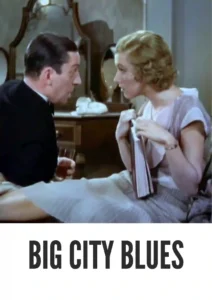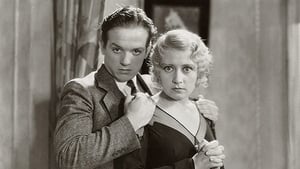Contact: [email protected]
Video Sources 0 Views
- Big City Blues


Synopsis
Table of Contents
ToggleReview: Big City Blues (1932) – A Gritty Tale of Survival in the Urban Jungle

Introduction
“Big City Blues” (1932) emerges as a gritty portrayal of life in the bustling metropolis during the early 1930s. This review delves into the significance of this classic film, exploring its depiction of urban struggles and its enduring relevance in the annals of cinematic history.
Check The Full Colorized Movies List
Check Our Colorized Movies Trailer Channel
Understanding Big City Blues 1932: Director, Cast, and Genre
Directed by Mervyn LeRoy, “Big City Blues” (1932) showcases his adeptness at capturing the raw essence of city life amidst the turmoil of the Great Depression. The film features a talented cast, including Joan Blondell, Eric Linden, and Jobyna Howland, who breathe life into their characters with authenticity and depth. Blending elements of drama, romance, and social commentary, “Big City Blues” (1932) offers a compelling glimpse into the lives of ordinary people navigating the harsh realities of urban existence.
Exploring the World of Big City Blues 1932: Plot and Characters
Set against the backdrop of New York City during the height of the Depression, “Big City Blues” (1932) follows the journey of Bud, a small-town boy who finds himself adrift in the urban jungle after winning a sweepstakes prize. As he navigates the treacherous streets of the city, he encounters a colorful cast of characters, from struggling artists to hardened criminals, each with their own dreams and desires. Amidst the chaos and uncertainty, Bud forms unexpected connections and discovers the true meaning of friendship, love, and survival.
The Art of Film Colorization
While “Big City Blues” (1932) predates the era of color film, its timeless themes and evocative imagery continue to resonate with audiences today. Through the art of colorization, the film’s black and white palette is transformed into a vibrant canvas of hues and tones, bringing the bustling streets of Depression-era New York to life in stunning detail. By infusing the film with color, modern audiences are afforded a fresh perspective on this classic tale of urban struggle and resilience.
Early Colored Films: A Brief History
The history of colored films traces its origins to the early days of cinema, with filmmakers experimenting with various techniques to add color to their productions. From hand-painted frames to early Technicolor processes, the evolution of colored film has been marked by innovation and experimentation. As technology advanced, so too did the art of colorization, paving the way for modern techniques that continue to captivate audiences with their vivid imagery and immersive storytelling.
Big City Blues 1932 and Its Early Colored Version
The decision to release “Big City Blues” (1932) in a colorized format represents a bold reinterpretation of this classic tale for modern audiences. By infusing the film with color, viewers are afforded a fresh perspective on the sights and sounds of Depression-era New York, from the neon-lit streets of Times Square to the smoky jazz clubs of Harlem. While some purists may balk at the idea of tampering with a beloved classic, others welcome the opportunity to experience “Big City Blues” (1932) in a new light, with all the vibrancy and vitality of a contemporary production.
The Debate Over Film Colorization
The debate over film colorization remains a contentious issue in the world of cinema, with proponents praising its ability to breathe new life into classic movies and introduce them to a new generation of viewers. Conversely, detractors argue that colorization compromises the artistic integrity of the original work and diminishes its historical significance. As the debate rages on, filmmakers and audiences alike are left to ponder the merits and drawbacks of colorization in the ever-evolving landscape of cinema.
Examining Big City Blues 1932 as an Early Colored Film
As with any colorized classic, the impact of colorization on “Big City Blues” (1932) is subject to personal interpretation. Some may argue that it enhances the film’s visual appeal and immerses viewers in its world, while others may feel that it detracts from the stark beauty of the original black and white version. Regardless of one’s stance on the issue, there’s no denying the enduring power of “Big City Blues” (1932) as a poignant portrayal of urban life during one of the most tumultuous periods in American history.
Influence and Legacy: Big City Blues 1932’s Impact on Cinema
“Big City Blues” (1932) has left an indelible mark on the world of cinema, inspiring countless filmmakers and captivating audiences with its timeless themes and evocative imagery. From its authentic portrayal of urban struggle to its heartfelt performances and memorable characters, the film continues to resonate with viewers of all ages, reaffirming its status as a true classic of the Depression-era drama genre.
Director’s Cinematic Legacy: Beyond Big City Blues 1932
Mervyn LeRoy’s influence extends far beyond “Big City Blues” (1932), with a diverse body of work that spans multiple genres and generations. From “Little Caesar” to “The Wizard of Oz,” LeRoy’s films are celebrated for their depth, complexity, and enduring relevance, solidifying his legacy as one of the preeminent directors of Hollywood’s Golden Age. Through his groundbreaking work, LeRoy has left an indelible imprint on the world of cinema, inspiring generations of filmmakers to follow in his footsteps.
Themes Explored in Big City Blues 1932
“Big City Blues” (1932) explores a myriad of themes, from the struggle for survival in the face of adversity to the enduring power of hope and resilience. Through its richly drawn characters and poignant storytelling, the film invites viewers to ponder the complexities of urban life and the universal human experiences that bind us together. As audiences immerse themselves in the world of “Big City Blues” (1932), they are reminded of the timeless truths that transcend time and place, offering solace and inspiration in the darkest of times.
Reception and Controversy Surrounding Big City Blues 1932
Upon its release, “Big City Blues” (1932) received widespread critical acclaim for its authentic portrayal of Depression-era New York and its compelling narrative. However, the decision to release the film in a colorized format sparked debate among purists, reigniting the age-old discussion surrounding film preservation and artistic integrity. Despite the controversy, “Big City Blues” (1932) remains a beloved classic that continues to captivate audiences with its timeless themes and evocative imagery, reaffirming its status as a true masterpiece of Depression-era cinema.
Where to Watch Big City Blues 1932 Online
For those eager to experience the timeless magic of “Big City Blues” (1932), the film is readily available on popular streaming platforms such as Netflix, Amazon Prime, and Hulu. Whether you choose to watch it in its original black and white format or the early colored version, “Big City Blues” (1932) promises to transport you to a world of grit, glamour, and survival in the urban jungle.
FAQs About Big City Blues 1932
Q: Is “Big City Blues” (1932) based on a true story? A: No, “Big City Blues” (1932) is a fictional tale crafted by screenwriters Robert N. Lee and Lillie Hayward, who drew inspiration from the social and economic realities of Depression-era America.
Q: Who are the main actors in “Big City Blues” (1932)? A: “Big City Blues” (1932) features an ensemble cast led by Joan Blondell, Eric Linden, and Jobyna Howland, whose authentic performances bring the characters to life with depth and nuance.
Q: What awards did “Big City Blues” (1932) win? A: While “Big City Blues” (1932) did not win any major awards, it received critical acclaim for its authentic portrayal of Depression-era New York and its compelling narrative.
Q: Why was “Big City Blues” (1932) released in a colorized format? A: The decision to release “Big City Blues” (1932) in color was made to introduce the film to a new generation of viewers and enhance its visual appeal for modern audiences. While the choice to colorize the film sparked debate among purists, it ultimately allowed “Big City Blues” (1932) to reach a wider audience and ensure its continued relevance in the annals of cinematic history.
Conclusion
“Big City Blues” (1932) stands as a testament to the resilience of the human spirit in the face of adversity, offering a poignant glimpse into the lives of ordinary people navigating the harsh realities of urban existence during the Great Depression. Whether viewed in its original black and white format or the early colored version, the film continues to captivate audiences with its timeless themes and evocative imagery, reaffirming its status as a true classic of Depression-era cinema.











